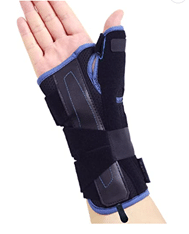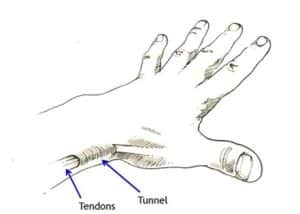Treatment
Many symptoms will settle with a period of rest and avoiding activities that cause pain.
Pain relief
Medication (such as simple painkillers or anti-inflammatories) may be useful. A pharmacist or healthcare practitioner can help advise you what to take if needed. You can find further information here on what medications you could take here:
How and when to take paracetamol for adults – NHS (www.nhs.uk)
Ibuprofen for adults: painkiller which also treats inflammation – NHS (www.nhs.uk)
Ice or heat therapy
You may find heat helpful to ease stiff and painful joints. Try filling a bowl with warm water or resting your hand on a microwaved heat pack for 10 minutes. Do not use heat if your joint is hot and swollen as it may make it worse. Instead you can consider using an ice pack or bag of frozen peas.
Place a tea towel on your wrist (to protect your skin from ice burns), and then place an ice pack or bag of frozen peas over the painful area. Leave this on for ten minutes and use up to 3 times per day.
- Please be cautious using ice if you have altered sensation or circulatory problems.
- Check the skin regularly, and stop if there is excessive pain or tingling.
Splinting
 Immobilising the wrist and the thumb with a splint (purchased online, or via a sports shop) for a short period (1-2 weeks) may help to settle the pain and inflammation. You could try this for two weeks, day and night. Take it off regularly to maintain the movement in your thumb wrist and fingers.
Immobilising the wrist and the thumb with a splint (purchased online, or via a sports shop) for a short period (1-2 weeks) may help to settle the pain and inflammation. You could try this for two weeks, day and night. Take it off regularly to maintain the movement in your thumb wrist and fingers.
Here is an example of a suitable splint you could try.
Changing the way you do things
Try and identify what caused your De Quervain’s and take steps to prevent it from happening again. Changing the way that you use your hands and taking regular breaks will help to reduce the strain on your tendons.
Avoid repetitive activities, especially those that involve the thumb, and activities where you hold an object still for a period of time with your wrist bent and the thumb wide open. For new Mothers, this may mean that you have to adapt to new ways of lifting and positioning your baby. Try using a pillow to help support your baby, avoid lifting or lift in a different way.
General movement of the hand and wrist can be beneficial to maintain range of movement and prevent stiffness.

 Immobilising the wrist and the thumb with a splint (purchased online, or via a sports shop) for a short period (1-2 weeks) may help to settle the pain and inflammation. You could try this for two weeks, day and night. Take it off regularly to maintain the movement in your thumb wrist and fingers.
Immobilising the wrist and the thumb with a splint (purchased online, or via a sports shop) for a short period (1-2 weeks) may help to settle the pain and inflammation. You could try this for two weeks, day and night. Take it off regularly to maintain the movement in your thumb wrist and fingers.